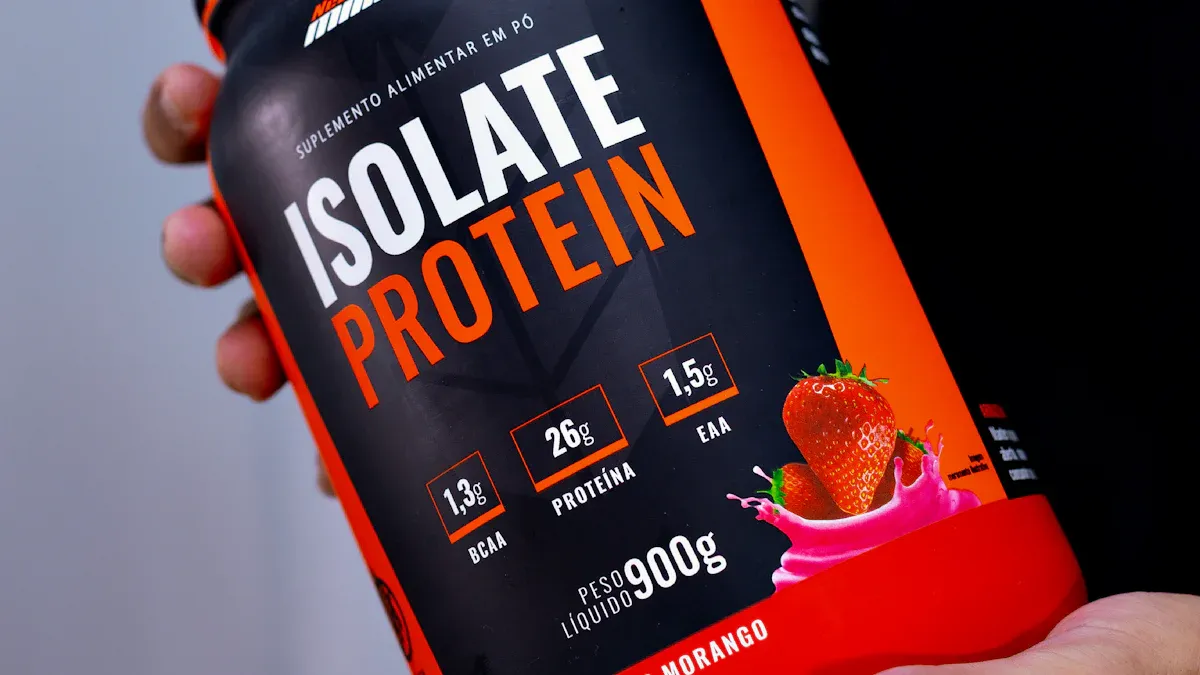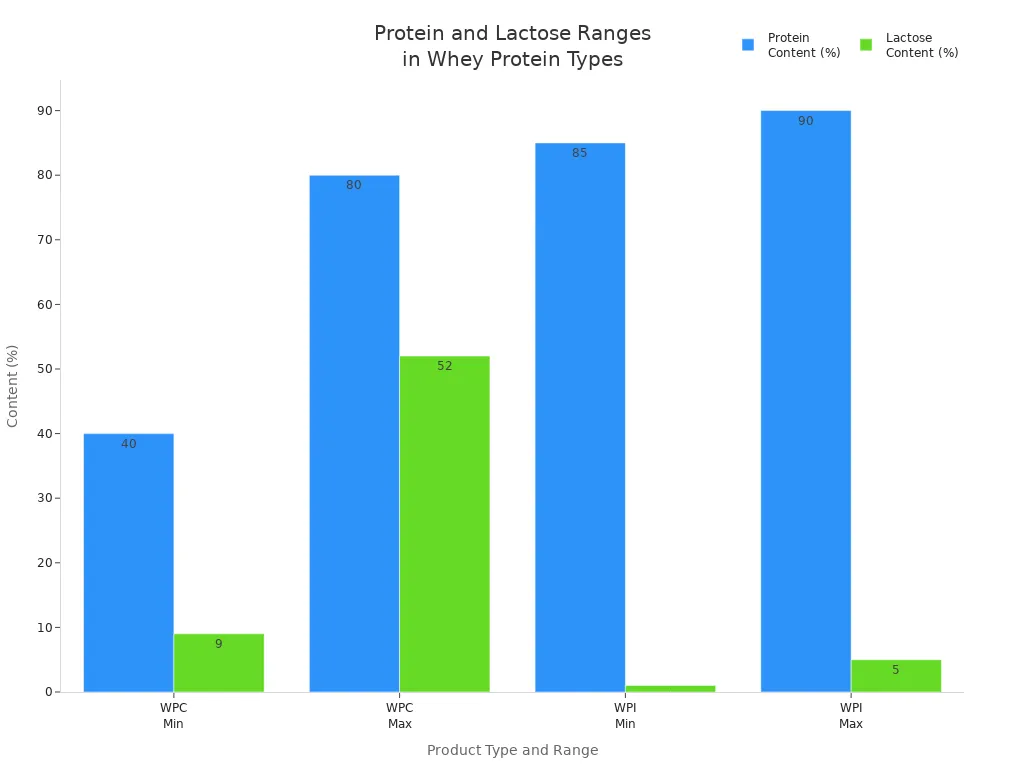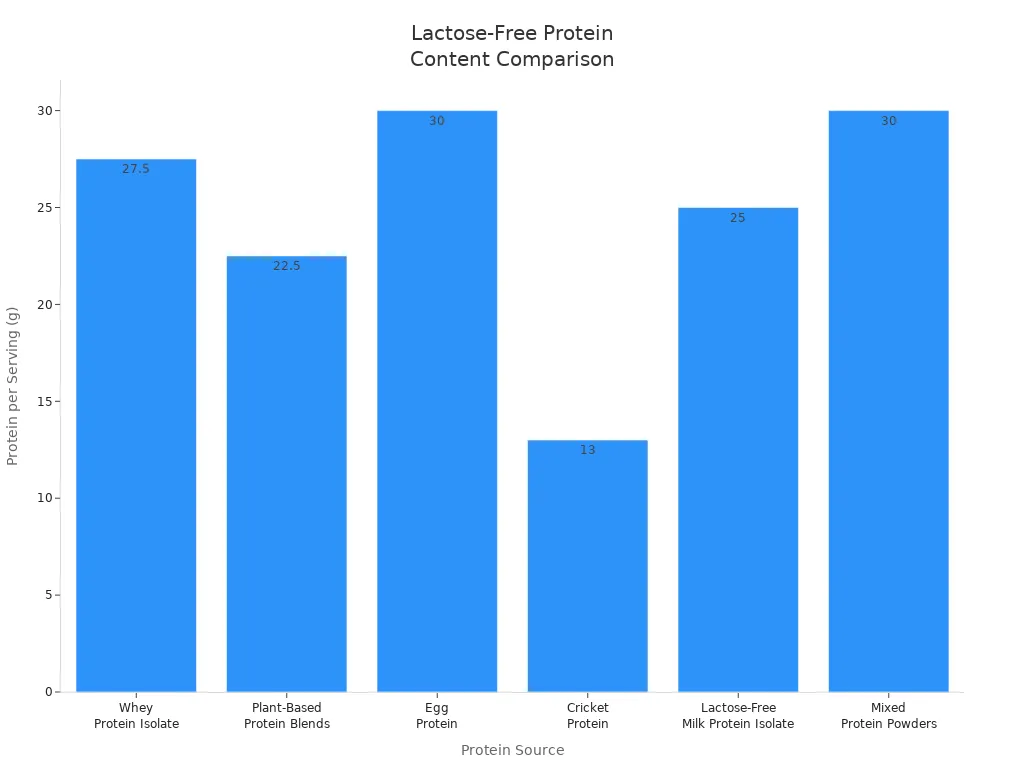Certain whey proteins like isolate and hydrolysate are safe for many people with lactose intolerance. Each product has a different amount of lactose in whey protein. This depends on the type and brand. People should check labels to find what works for them. A healthcare provider can help someone choose the best protein for their needs.
Key Takeaways
-
Whey protein isolate and hydrolysate have very little lactose. They are usually safe for people with lactose intolerance. Whey protein concentrate has more lactose. It may cause stomach pain or bloating. Always read product labels to check the type of whey protein. Look for words like ‘lactose-free’ or ‘whey protein isolate’. Start with a small amount of whey protein to see how your body feels. You can use lactase supplements if you need them. Plant-based proteins like pea, soy, and rice do not have lactose. They are good choices and give you good nutrition.
Lactose Intolerance
Definition
Lactose intolerance means your body cannot break down lactose. Lactose is a sugar in milk and dairy foods. This happens when your small intestine does not make enough lactase. Lactase is an enzyme that helps digest lactose. If you do not have enough lactase, lactose stays undigested. It moves into your colon. Bacteria in the colon break down the lactose. This causes symptoms that feel uncomfortable.
Lactose intolerance is very common in many places. How common it is depends on where people live and their background. The table below shows how often lactose intolerance happens in different groups:
|
Source/Study |
Prevalence Estimate |
Population Notes |
|---|---|---|
|
Medscape overview |
High in Asian, South American, and African populations |
|
|
Storhaug et al., 2017 (meta-analysis) |
68% |
62,910 participants from 89 countries |
|
NIH/NIDDK |
About 68% |
Lower in northern Europe; ~36% in the US |
|
US National Institute of Health |
65% |
Up to 95% in Asia |
About 36% of people in the United States have lactose intolerance. In Asia and Africa, up to 95% of people may have it. People in northern Europe have the lowest rates.
Symptoms
Lactose intolerance causes problems with digestion. These problems usually start about one hour after eating or drinking lactose. How bad the symptoms are depends on how much lactose you eat and how much lactase your body makes.
Some common symptoms are:
-
Stomach pain
-
Bloating
-
Gas
-
Diarrhea
-
Stomach cramps
-
Nausea
-
Sometimes vomiting
These symptoms happen because lactose is not digested. The lactose goes to the colon. Bacteria there break it down and make gas and acids. This causes the symptoms listed above. How much lactose you eat, the kind of food, and your own body all matter. Some people can eat a little lactose with no problem. Others feel sick even with a small amount.
Types of Whey Protein

Whey protein has three main types. These are concentrate, isolate, and hydrolysate. Each type has different amounts of protein and lactose. How much lactose is left depends on how it is made.
Concentrate
Whey protein concentrate is not processed much. It keeps more natural sugars like lactose. The protein in concentrate can be from 40% to 80%. When there is more protein, there is less lactose. For example, WPC 35 has about 34–36% protein and 48–52% lactose. WPC 80 has 80–82% protein and only 4–8% lactose. In 100 grams of concentrate, there are about 3.5 grams of lactose. People with lactose intolerance may get symptoms from this type.
|
Whey Protein Concentrate Type |
Protein (%) |
Lactose (%) |
|---|---|---|
|
WPC 35 |
34–36 |
48–52 |
|
WPC 50 |
50–52 |
33–37 |
|
WPC 80 |
80–82 |
4–8 |
Isolate
Whey protein isolate is processed more. This takes out most carbs and fats, including lactose. Isolate usually has over 85% protein. The lactose is less than 5%. Many brands have less than 1 gram of lactose per serving. Some brands, like BiPro ELITE, NOW Sports, and Klean Athlete, say their isolates are lactose free or almost lactose free. People with lactose intolerance often pick isolate because it has very little lactose.

Hydrolysate
Whey protein hydrolysate is the most processed. The protein is broken into smaller pieces. This makes it easier to digest. Hydrolysate comes from isolate, so it also has very little lactose. Most hydrolysate has less than 1.5% lactose by weight. Some brands, like Optimum Nutrition’s Platinum Hydrowhey, use special filters to remove almost all lactose. This makes hydrolysate a good choice for people who are sensitive to lactose.
Tip: More processing means less lactose in whey protein. Isolate and hydrolysate are better for people with lactose intolerance.
Lactose in Whey Protein
Content by Type
How much lactose is in whey protein depends on its type. Each type is made in a different way. Some types keep more lactose, but others take most of it out. People with lactose intolerance should know these facts.
The table below shows how much protein and lactose each type has:
|
Whey Protein Type |
Protein Content Range |
Lactose Content |
|---|---|---|
|
Whey Protein Concentrate |
Has lactose (amount changes) |
|
|
Whey Protein Isolate |
Around 95% |
Very little lactose (~5%) |
|
Whey Protein Hydrolysate |
Around 99% |
Almost no lactose |
Whey protein concentrate has the most lactose. The amount depends on how much protein is in it. Whey protein isolate has much less lactose. Most isolates have only a tiny bit left after making them. Hydrolysate has the least lactose. Extra steps in making hydrolysate break down the protein and remove almost all lactose.
Note: If you react to even a little lactose, pick isolate or hydrolysate. These types have much less lactose than concentrate.
Factors Affecting Levels
Many things can change how much lactose is in whey protein. Filtration methods are important. Membrane filtration and ion exchange take out proteins and solids from whey. This leaves permeate, which has a lot of lactose. If a brand adds permeate or uses deproteinized whey, the lactose goes up.
Brand choices also matter. Some companies add things like permeate for taste or texture. These extras make the lactose higher. Always check the ingredient list for “whey permeate” or “deproteinized whey.”
Processing changes how whey protein works. When there is more lactose than protein, more Maillard reaction products form. This means lactose in whey protein changes taste, nutrition, and safety for people with lactose intolerance.
Always read labels and look for lactose details in whey protein. Each brand and product can be different. Picking products with clear info helps people avoid feeling sick.
Brand Comparison
Low-Lactose Options
Many people with lactose intolerance want whey protein with little lactose. Some brands make products for these people. The table below shows a popular brand:
|
Brand & Product |
Protein Type |
Lactose Content |
Third-Party Tested |
Protein Per Serving |
Flavors Available |
|---|---|---|---|---|---|
|
Whey protein isolate |
Very low (suitable for lactose intolerance) |
Yes (Informed Sport) |
25 grams |
Creamy Vanilla, Dutch Chocolate |
Sports Research Whey Protein Isolate is made to have less lactose. Dietitians and athletes say it tastes good and is high quality. This protein also has BCAAs and vitamin D.
Tigerwhey is another choice. One scoop of Tigerwhey Unflavored Whey has 1.8 grams of lactose. This is much less than milk, which has about 12 grams in one cup. The lactose in Tigerwhey is like two and a half tablespoons of milk. Some whey protein isolates have no lactose, but Tigerwhey is just low in lactose. People who want less lactose in their whey protein can pick these brands.
Label Reading
Reading labels helps people pick the right whey protein. Here are some tips:
-
Whey concentrate has the most lactose. It may not be good for people with lactose intolerance.
-
Whey isolate and hydrolysate have much less lactose. These are better for people who are sensitive.
-
Look for “lactose-free.” This means almost all the lactose is gone.
-
Most labels do not show the exact lactose amount. Find the protein type and any lactose-free words.
-
Learn words like “whey permeate” or “deproteinized whey.” These can mean more lactose.
Tip: Start by reading the label when choosing whey protein. Knowing the type and claims helps you avoid feeling sick.
Safety for Lactose Intolerance
Individual Tolerance
People with lactose intolerance react differently to whey protein. Some people can have a little lactose. Others cannot have any at all. The body makes an enzyme called lactase. This enzyme helps break down lactose. If your body makes less lactase, you may feel sick after eating lactose. The kind of whey protein you pick is important. Whey protein concentrate has the most lactose. Isolate and hydrolysate have much less. Special ways of making these proteins remove more lactose. This makes them easier for many people to use.
The table below shows what can change how much lactose someone can handle:
|
Factor |
Description |
|---|---|
|
Severity of Lactose Intolerance |
How much lactose you can eat depends on how bad your intolerance is. Some people can have a little. Others cannot have any. |
|
Type of Whey Protein |
Concentrate has the most lactose. Isolate has less. Hydrolysate has the least. |
|
Lactase Enzyme Production |
If your body makes more lactase, you can digest more lactose. |
|
Processing Methods |
Filtering and isolating whey protein takes out more lactose. This helps people tolerate isolate and hydrolysate better. |
|
Individual Variation |
Everyone is different. Watch for symptoms and talk to a doctor if you need help. |
A study showed that people who make less lactase get more stomach problems from foods with more lactose. This means the amount of lactose in whey protein can change how you feel. Watch for signs of stomach trouble. Ask a doctor if you are worried.
Lactase Supplements
Lactase supplements can help people with lactose intolerance eat foods with lactose. These pills or drops give your body extra lactase. You can take them before eating or drinking things like whey protein concentrate. This can help stop stomach pain, gas, or diarrhea.
Some whey protein powders have lactase already added. These break down most of the lactose before you drink them. If you worry about symptoms, you can try these products. Lactase supplements work best if you use them the right way and with foods that have known lactose amounts.
Symptom Management
It is important to manage symptoms if you have lactose intolerance and want to use whey protein. The most common problems are bloating, gas, cramps, diarrhea, and sometimes constipation. These happen when your body cannot break down all the lactose in whey protein concentrate. Isolate and hydrolysate usually cause fewer problems because they have less lactose.
Doctors and dietitians suggest some ways to help:
-
Pick isolate or hydrolysate because they have less lactose.
-
Take lactase supplements before using whey protein with more lactose.
-
Do not mix whey protein with regular milk. Use water or lactose-free milk.
-
Eat small amounts of lactose at different times during the day.
-
Check labels for extra lactose or words like whey permeate.
-
Try probiotics or ask a doctor for other ways to help your stomach.
Tip: Begin with a small amount of whey protein. Watch for any symptoms. If you feel fine, you can slowly use more.
If you still have problems after trying these ideas, you might want to use non-dairy protein powders. Soy, pea, or rice protein do not have lactose. These are safe for people who react to lactose in whey protein.
Alternatives

Plant-Based Proteins
Plant-based protein powders are good for people with lactose intolerance. These powders do not have any dairy or lactose. Many brands, like Orgain, make vegan protein powders. They use peas, brown rice, and oats. These products are USDA organic and non-GMO. This makes them a healthy choice for many people.
Pea and soy proteins are the most common choices. They have a lot of protein and do not cost much. Oat and brown rice proteins are getting more popular. People like them if they want allergy-friendly or earth-friendly options. The table below lists some top plant-based proteins and why people pick them:
|
Plant-Based Protein Alternative |
Popularity Reasons |
Market Drivers |
Leading Companies |
|---|---|---|---|
|
Pea Protein |
High protein, affordable, easy to find |
Vegan trends, lactose intolerance, sustainability |
Vega, Garden of Life, Orgain |
|
Soy Protein |
High protein, affordable, complete amino acids |
Same as above |
Vega, Garden of Life, Orgain |
|
Oat Protein / Oat Milk |
Lactose-free, sustainable, allergy-friendly |
North American popularity, lactose intolerance |
Various oat milk brands |
|
Brown Rice Protein |
Novel, plant-based, easy to digest |
Taste, texture, bioavailability |
Emerging brands |
Plant-based proteins do not have lactose. They also give extra nutrients like fiber, iron, zinc, and magnesium. These nutrients help your immune system and metabolism. Most plant-based powders are easy to digest. But some may have allergens like soy or gluten. Always check the label before you buy.
Many people in Asia, Africa, and Latin America use plant-based proteins. Lactose intolerance is common in these places. Oat milk and almond milk are also popular as dairy substitutes.
Other Lactose-Free Options
People who want no lactose have other protein choices. Lactose-free whey protein isolate and hydrolysate have almost no lactose. They keep all the amino acids. These types help muscles recover and are easy to absorb.
Egg protein is another good choice. It is easy to digest and works like whey. Some people use beef protein isolate, bone broth protein, or cricket protein. Each one has different protein amounts and how well your body uses it. The chart below shows the protein in these lactose-free options:

The table below lists important facts about these protein sources:
|
Protein Source |
Lactose-Free |
Protein Content per Serving (g) |
Bioavailability / Notes |
|---|---|---|---|
|
Whey Protein Isolate |
Yes |
25-30 |
High bioavailability, complete amino acids |
|
Plant-Based Protein Blends |
Yes |
21-24 |
Complete amino acids, lower bioavailability |
|
Egg Protein |
Yes |
~30 |
Very high digestibility, comparable to whey |
|
Beef Protein Isolate |
Yes |
N/A |
High essential amino acids, less bioavailable |
|
Bone Broth Protein |
Yes |
N/A |
Contains collagen, supports joints |
|
Cricket Protein |
Yes |
~13 |
Sustainable, all essential amino acids |
|
Lactose-Free Milk Protein Isolate |
Yes |
25 |
High bioavailability, lactose removed |
People should pick a protein that fits their digestion, diet, and fitness goals. Lactose-free whey protein is still great for building muscle. Plant-based and egg proteins are also good for people who do not want dairy.
Whey protein isolate and hydrolysate are good choices for most people with lactose intolerance. Doctors say to start with a small amount and see how you feel. Always read the label and talk to your doctor if you have questions.
-
Hydrolyzed whey and isolate have very little lactose and are easy to digest.
-
Plant-based proteins are a good choice if you want something with no lactose.
|
Global Trend |
Impact |
|---|---|
|
More people want lactose-free and plant-based protein supplements |
Tip: Pick products with clear labels and try a small amount first to see what works for you.
FAQ
Can people with lactose intolerance use whey protein every day?
Most people with lactose intolerance can use whey protein isolate or hydrolysate each day. These types have almost no lactose. It is smart to begin with a small amount. They should watch for any symptoms.
How can someone tell if a whey protein is lactose-free?
People need to look at the label for words like “lactose-free” or “whey protein isolate.” Some brands show how much lactose is in the product. If they are not sure, they can ask the company or pick a plant-based protein.
Does mixing whey protein with milk increase lactose?
Yes, adding regular milk to whey protein gives you more lactose. People with lactose intolerance should use water or lactose-free milk instead. This helps them avoid extra lactose.
Are there any side effects from using lactase supplements?
Some people might get a little stomach upset from lactase supplements. Most people do not have problems. They should always use the supplements as the package says.
What is the best alternative to whey protein for lactose intolerance?
Plant-based proteins like pea, soy, or rice protein are good choices. These do not have any lactose. They also give good nutrition for people who cannot have dairy.

